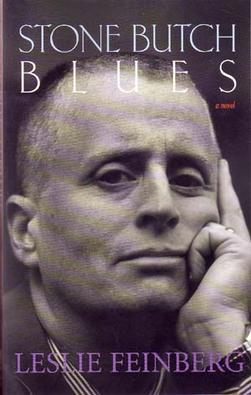Wikipedia gives the summary, “Stone Butch Blues is a novel written by the revolutionary communist Leslie Feinberg about life as a butch lesbian in 1970s America.”
Generally with a book like this, I try to get the background and plot before I read it, so that I’m able to absorb it all. I started doing the background research on this book, and quickly felt overwhelmed. I decided to just dive in. I’m glad I did it that way because the style is very unusual and I think the best way to go through this text is just to do it, and then follow up with the research.
It’s written as a straight-narrative. There are no time jumps or anything. It just goes through the coming out story or a person who seems very similar to Leslie Feinberg. Jess works in factories, figures out that she’s a lesbian, works some more, figure out that she’s a man, transitions, and then continues his life.
There are several moments that really stand out in a memorable way for me:
“We’re supposed to dress up,” Ed yelled.
“Yeah, of course.”
“No,” she shouted. “You know, like girls…”
“II don’t put on a dress for nobody!” She told me we were going to a funeral home to see a body, not knocking on heaven’s gate to get let in. I couldn’t put on a dress. I shuddered at the thought. Besides, it was a moot point — I didn’t own one.
This is a fascinating moment. A respected older lesbian has died. It’s bizzare to think that the older lesbians in the group would expect the younger members to compromise their identities as a way of showing respect. This felt like strong foreshadowing that Jess was more than just a lesbian.
“It’s just incredible. I can’t believe you’ve given me the sky to sleep under. But I can’t tell if it’s dawn or dusk you’ve painted.”
She smiled up at the ceiling. “It’s neither. It’s both. Does that unnerve you?”
I nodded slowly. “Yeah, in a funny way it does.”
“I figured that,” she said. “It’s the place inside of me I have to accept. I thought it might be what you need to deal with, too.”
I think this is a critical moment in the text. Basically, it could be seen not just as a microcosm for the entire story, but for the story of every queer person. In Ruth’s words, “It’s the place inside of me I have to accept. I thought it might be what you need to deal with, too.” Queer people grow up living a lie in self defense and spend out lives deconstructing the lies to search for the truth underneath.
In some ways this is a universal human struggle, and maybe at least in that way, everyone is a little bit queer. No one is exactly who they want to be, and no one is exactly who society wants them to be. Drawing the lines between all these things and coming to understand the similarities and differences between who we are and who we’re supposed to be is one of the most fundamental and important aspects of life. Freud called this Cognitive Dissonance. Foucault called in Panopticism. Sociologists call it performativity or strain. They’re all talking about the same thing, and this passage does an excellent job of concisely explaining this core human process.
This book was hard to read, and hard to understand, and I think I will recommend it to people.
